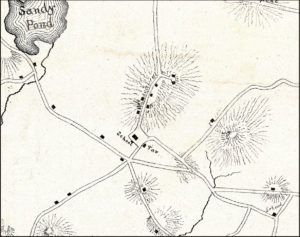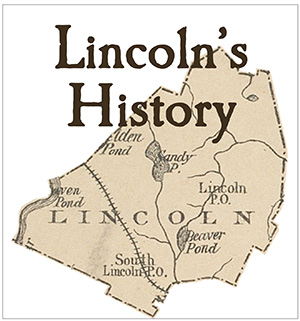By Kerry Glass
One way to keep out traffic: Don’t tell travelers where the roads are.
For the first 75 years after Lincoln was founded, the town felt no need for an official road map. The roads ran where Lincoln residents needed them, and new roads were created and old ones were closed by debate and decision in Lincoln’s town meetings. The road “maps” were scrawled descriptions by the town clerk in town records: “beginning at Lexington line, so running southerly over John Headley’s land and through Joseph Brooks’ land, the said Brooks to have liberty to hang a gate on the said way at his southerly bounds.”
Then in 1794, the Great and General Court required all towns to submit “accurate plans” of their borders, rivers, bridges, and roads. But only county roads had to be shown on these maps. So that is all that Samuel Hoar, the town surveyor, included when he drew up the town’s official map—just four county roads, one in north Lincoln and three in south Lincoln. It was not until 1830 that the Commonwealth required towns to submit maps showing all town roads. Lincoln had no choice and finally produced a complete road map. Yet even on this map, no names were shown for the roads (that’s a story for another time!).

Part of an 1830 map of Lincoln by John G. Hales. showing the town center — and the lack of road names. Source: Digital Commonwealth.
The town felt strongly that even these county roads mainly benefited other towns but not Lincoln. And so the town resisted. The Concord/Cambridge Turnpike (now Route 2) was a good example. The path of the turnpike was laid out in 1803, and it plowed through hills and wetlands in Lincoln, just so travelers between Cambridge and Concord would have the shortest and straightest route possible. Lincoln fought unsuccessfully against the turnpike, and later the town also resisted straightening the paths of two other roads through town—the Middle Road (now Trapelo Road) and the North Road (now Route 2A).
Lincoln had more success in preventing a major highway from running north and south through the heart of town. To this day, in contrast to neighboring towns, Lincoln does not have a numbered highway running through its town center.
For more on the history of Lincoln’s roads, see Tracing the History of Lincoln’s Ways, a 2019 manuscript by Kerry Glass, accessible by contacting the Lincoln Historical Society.
“Lincoln’s History” is an occasional column by members of the Lincoln Historical Society.

Very interesting. Really enjoy these snippets of Lincoln History that appear in Lincoln Talk and the Squirrel. Thanks to members of the Lincoln Historical Society for reminding us all of Town history.
Hi, Kerry. Interesting, as always. Gotta Love Lincoln! New town motto?
I too am enjoying this history series. And this very interesting article on our roadways.
Maybe you can put the whole Glass manuscript on the LHS website?
Mary Ann Hales